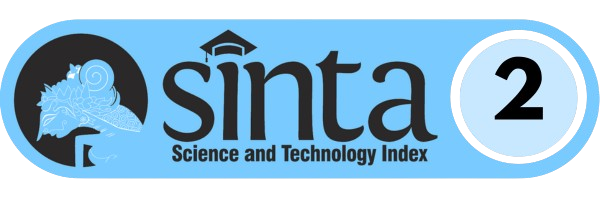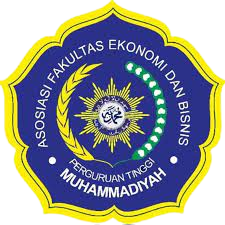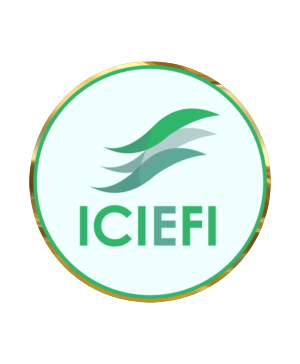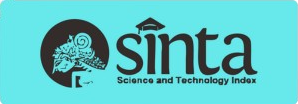Uncovering the Map of Poverty in the South Coast Region of East Java: A New Perspective from Spatial Analysis
DOI:
https://doi.org/10.24269/ekuilibrium.v20i2.2025.pp354-375%20Keywords:
Spatial Dependence , Poverty, Sustainable development goals (SDGs), South Coast RegionAbstract
Poverty alleviation remains a global challenge and a key pillar of the sustainable development agenda. Unlike previous studies that generally examine poverty in aggregate or without considering spatial linkages, through the incorporation of socioeconomic and environmental dimensions into the Spatial Durbin Model (SDM), this research introduces a novel approach to investigating spatial interdependencies of poverty across the South Coast of East Java Province. The analysis using Spatial Weighting Matrix, Moran Index Analysis, Terting the significance of Spatial Parameters, Spatial Panel Model and Goodness of Fit Criteria that poverty in one locality is substantially shaped by the socioeconomic conditions prevailing in adjacent areas. The results show that economic growth and natural resource exploitation has a positive significant on poverty. This suggests that growth and resource exploitation do not necessarily reduce poverty. Conversely, accessibility has a negative and significant effect, confirming that increased connectivity can reduce poverty disparities between regions. Education, unemployment, and health factors show weaker or insignificant effects, although their spatial interactions remain important. The synthesis of these findings confirms that poverty in coastal areas is not merely a local issue, but a spatially contagious phenomenon. The practical implication of this research highlights the necessity of spatial-based policies that fast prioritize inclusive growth, equitable resource allocation, and the development of strategic infrastructure in order to break the cycle of poberty while maximizing positive splillover effects. Thus, this research not only enriches the literature on spatial economics but also provides concrete policy direction for accelerating poverty alleviation in line with sustainable development goals.
References
Abaidoo, Anthony. 2021. “The Nexus between Education and Poverty Reduction in Ghana from 2013 to 2017.” Cogent Social Sciences 7(1). doi: 10.1080/23311886.2021.1986933.
Acconcia, Antonio, Maria Carannante, Michelangelo Misuraca, and Germana Scepi. 2020. “Measuring Vulnerability to Poverty with Latent Transition Analysis.” Social Indicators Research 151(1):1–31. doi: 10.1007/s11205-020-02362-3.
Addae-korankye, Alex. 2019. “Theories of Poverty: A Critical Review.” Journal of Poverty, Investment and Development (2012):55–62. doi: 10.7176/jpid/48-08.
Adeleye, Bosede Ngozi, Obindah Gershon, Adeyemi Ogundipe, Oluwarotimi Owolabi, Ifeoluwa Ogunrinola, and Oluwasogo Adediran. 2020. “Comparative Investigation of the Growth-Poverty-Inequality Trilemma in Sub-Saharan Africa and Latin American and Caribbean Countries.” Heliyon 6(12). doi: 10.1016/j.heliyon.2020.e05631.
Álvarez-Gamboa, Javier, Pablo Cabrera-Barona, and Hugo Jácome-Estrella. 2021. “Financial Inclusion and Multidimensional Poverty in Ecuador: A Spatial Approach.” World Development Perspectives 22(November 2020). doi: 10.1016/j.wdp.2021.100311.
Amaliah, Y., and M. Ulimaz. 2021. “Spatial Modeling on the Influence of Social Network and Infrastructure Accessibility on the Number of Poverty Alleviation Program Recipients in Budaya Pampang Village.” IOP Conference Series: Earth and Environmental Science 739(1). doi: 10.1088/1755-1315/739/1/012054.
Arif, Muhammad, Lutfi Muta’ali, and R. Rijanta. 2025. “Mapping Poverty Traps in Indonesia: A Spatial Perspective.” Regional Statistics 15(2):341–64. doi: 10.15196/rs150207.
Aue, Katja, Jutta Roosen, and Helen H. Jensen. 2016. “Poverty Dynamics in Germany: Evidence on the Relationship between Persistent Poverty and Health Behavior.” Social Science and Medicine 153:62–70. doi: 10.1016/j.socscimed.2016.01.040.
Auty, Richard M. 1995. “Economic Development and the Resource Curse Thesis.” Economic and Political Reform in Developing Countries (1992):58–80. doi: 10.1007/978-1-349-13460-1_4.
Badeeb, Ramez Abubakr, Hooi Hooi Lean, and Jeremy Clark. 2017. “The Evolution of the Natural Resource Curse Thesis: A Critical Literature Survey.” Resources Policy 51(October 2016):123–34. doi: 10.1016/j.resourpol.2016.10.015.
Bintang, Aria Bhaswara Mohammad, and Nenik Woyanti. 2018. “Pengaruh PDRB, Pendidikan, Kesehatan, Dan Pengangguran Terhadap Tingkat Kemiskinan Di Jawa Tengah (2011-2015).” Media Ekonomi Dan Manajemen 33(1):20–28. doi: 10.24856/mem.v33i1.563.
Bird, Kate. 2019. “Addressing Spatial Poverty Traps.” Eradicating Rural Poverty to Implement the 2030 Agenda for Sustainable Development (February):1–17.
BPS Provinsi Jatim. 2024. “Volume 3, 2024.” 3.
Cahyadi, N., I. D. Wibisono, E. Syamsulhakim, and A. Setiawan. 2020. “Towards Spatial Poverty Targeting: Identification of Poverty Clustering in Indonesia.” (July).
Chen, Jiandong, Yun Wang, Jie Wen, Fuqian Fang, and Malin Song. 2016. “The Influences of Aging Population and Economic Growth on Chinese Rural Poverty.” Journal of Rural Studies 47:665–76. doi: 10.1016/j.jrurstud.2015.11.002.
Christie, Gillian P., and Scott C. Ratzan. 2019. “Beyond the Bench and Bedside: Health Literacy Is Fundamental to Sustainable Health and Development.” Information Services and Use 39(1–2):79–92. doi: 10.3233/ISU-180037.
David, Anda, Nathalie Guilbert, Nobuaki Hamaguchi, Yudai Higashi, Hiroyuki Hino, Murray Leibbrandt, and Muna Shifa. 2018. (Spatial) - Spatial Poverty and Inequality in South Africa: A Municipality Level Analysis.
Deffinika, Ifan, Singgih Susilo, Budijanto, Muhammad Noval Abdillah, Biffanca Allya Kenedy, Inanditya Widiana Putri, Astrid Tharissa Az Zachra, Swastika Dhesti Anggriani, and Dewi Kumalasari. 2025. “Socio-Spatial Analysis of Poverty: A Comprehensive Study on Integrating Multidimensional Poverty Indices with Geographic Conditions in Krucil District, Probolinggo, Indonesia.” Journal of Population and Social Studies 33:651–68. doi: 10.25133/JPSSV332025.035.
Dollar et al. 2015. “Growth Still Is Good for the Poor We Would like to Thank, without Implication.”
Elhorst, J. Paul, Rodolphe Devillers, Francis Group, Determinantes Del, Turismo Internacional, and Marcio José. 2014. “Spatial Econometrics From Cross-Sectional Data to Spatial Panels.” 16:436–57.
Faridi, Muhammad, Muhammad Chaudhry, Fatima Farooq, and Romaisa Arif. 2016. “Labor Force Participation and Poverty Alleviation in Pakistan: An Empirical Analysis Romaisa Arif.” Pakistan Journal of Social Sciences (PJSS) 36(2):1251–63.
Garza-Rodriguez, Jorge, Gustavo A. Ayala-Diaz, Gerardo G. Coronado-Saucedo, Eugenio G. Garza-Garza, and Oscar Ovando-Martinez. 2021. “Determinants of Poverty in Mexico: A Quantile Regression Analysis.” Economies 9(2):1–24. doi: 10.3390/economies9020060.
Ge, Yong, Zhoupeng Ren, and Yangyang Fu. 2021. “Understanding the Relationship between Dominant Geo-Environmental Factors and Rural Poverty in Guizhou, China.” ISPRS International Journal of Geo-Information 10(5). doi: 10.3390/ijgi10050270.
Hajad, Vellayati, Ikhsan Ikhsan, Herizal Herizal, Ikhwan Rahmatika Latif, and Nodi Marefanda. 2023. “Poverty and the Curse of Natural Resources in Indonesia.” Journal of Contemporary Governance and Public Policy 4(1):41–58. doi: 10.46507/jcgpp.v4i1.92.
Hidalgo, Marisa Hidalgo, and Iñigo Iturbe-Ormaetxe Kortajarene. 2014. “Long-Run Effects on Poverty of Public Expenditure in Education.” Working Papers. Serie AD (April).
Hofmarcher, Thomas. 2021. “The Effect of Education on Poverty: A European Perspective.” Economics of Education Review 83(April):102124. doi: 10.1016/j.econedurev.2021.102124.
Kalle Hirvonen, Elia Machado, Andrew M. Simons. 2024. “This Document Is Discoverable and Free to Researchers across the Globe Due to the Work of AgEcon Search . Help Ensure Our Sustainability .” AgEcon Search 1–26.
Kassa, Getahun, Biruktait Teferi, and Nardos Delelegn. 2018. “The Poverty - Environment Nexus in Developing Countries: Evidence from Ethiopia: A Systematic Review.” Asian Journal of Agricultural Extension, Economics & Sociology 24(3):1–13. doi: 10.9734/ajaees/2018/39310.
Liang, Yutian, Shangqian Li, Jiaqi Zeng, and Tianbang Wu. 2022. “Examining the Impact of Multidimensional Accessibility on Regional Poverty in Laos.” Applied Geography 148(February):102789. doi: 10.1016/j.apgeog.2022.102789.
Listyaningsih, U., S. Satiti, and A. S. Kurniawidi. 2021. “Spatial Poverty of Poverty Alleviation in Bantul Districts of Yogyakarta.” IOP Conference Series: Earth and Environmental Science 738(1). doi: 10.1088/1755-1315/738/1/012046.
Liu, Mengxiao, Yong Ge, Shan Hu, and Haiguang Hao. 2023. “The Spatial Effects of Regional Poverty: Spatial Dependence, Spatial Heterogeneity and Scale Effects.” ISPRS International Journal of Geo-Information 12(12). doi: 10.3390/ijgi12120501.
Liu, Mengxiao, Yong Ge, Shan Hu, Alfred Stein, and Zhoupeng Ren. 2022. “The Spatial–Temporal Variation of Poverty Determinants.” Spatial Statistics 50:100631. doi: 10.1016/j.spasta.2022.100631.
Liu, Mengxiao, Shan Hu, Yong Ge, Gerard B. M. Heuvelink, Zhoupeng Ren, and Xiaoran Huang. 2021. “Using Multiple Linear Regression and Random Forests to Identify Spatial Poverty Determinants in Rural China.” Spatial Statistics 42:100461. doi: 10.1016/j.spasta.2020.100461.
Marrero, Gustavo A., and Luis Servén. 2022. “Growth, Inequality and Poverty: A Robust Relationship?” Empirical Economics 63(2):725–91. doi: 10.1007/s00181-021-02152-x.
Martens, Karel, and Jeroen Bastiaanssen. 2019. An Index to Measure Accessibility Poverty Risk. Elsevier Inc.
Mdingi, Kholeka, and Sin Yu Ho. 2021. “Literature Review on Income Inequality and Economic Growth.” MethodsX 8(May):101402. doi: 10.1016/j.mex.2021.101402.
Mikalauskiene, Asta, Raminta Narutaviciute-Cikanauske, Ingrida Sarkiunaite, Dalia Streimikiene, and Rumyana Zlateva. 2018. “Social Aspect of Sustainable Development: Issues of Poverty and Food Shortage.” Montenegrin Journal of Economics 14(2):59–78. doi: 10.14254/1800-5845/2018.14-2.4.
Mohammad, Umar Faruk, and Joseph David. 2019. “The Relationship between Poverty and Unemployment in Niger State.” Signifikan: Jurnal Ilmu Ekonomi 8(1):71–78. doi: 10.15408/sjie.v8i1.6725.
Mussagy, Ibraimo Hassane, and Ignatius Isaac Dambudzo. 2015. “A Spatial Analysis Of Poverty And Roads Network In Sofala Province.” Journal of International Academic Research for Multidisciplinary 3(7):319–28.
Pemerintah Provinsi, Jawa Timur. 2017. “Dokumen Final Penyusunan RZWP-3-K Provinsi Jawa Timur.” 1–585.
Quy, Nguyen Hoang. 2016. “Relationship between Economic Growth, Unemployment and Poverty: Analysis at Provincial Level in Vietnam.” International Journal of Economics and Finance 8(12):113. doi: 10.5539/ijef.v8n12p113.
Rachman, Tahar. 2018. “How to Acheive Inclusive Growth.” Angewandte Chemie International Edition, 6(11), 951–952. 720.
Renahy, Emilie, Christiane Mitchell, Agnes Molnar, Carles Muntaner, Edwin Ng, Farihah Ali, and Patricia O’Campo. 2018. “Connections between Unemployment Insurance, Poverty and Health: A Systematic Review.” European Journal of Public Health 28(2):269–75. doi: 10.1093/eurpub/ckx235.
Rustiadi, E. 2018. Perencanaan Dan Pengembangan Wilayah.
Schleicher, Judith, Marije Schaafsma, Neil D. Burgess, Chris Sandbrook, Fiona Danks, Chris Cowie, and Bhaskar Vira. 2018. “Poorer without It? The Neglected Role of the Natural Environment in Poverty and Wellbeing.” Sustainable Development 26(1):83–98. doi: 10.1002/sd.1692.
Škare, Marinko, and Romina Pržiklas Družeta. 2016. “Poverty and Economic Growth: A Review.” Technological and Economic Development of Economy 22(1):156–75. doi: 10.3846/20294913.2015.1125965.
Sukandar, Chuldyah J. Harsindhi, Muliawati Handayani, Citra Satriya Utama Dewi, Arsyii Wisuda Maulana, Supriyadi, and Ali Bahroni. 2016. “Profil Desa Pesisir Provinsi Jawa Timur Volume 2 (Selatan Jawa Timur).” Bidang Kelautan, Pesisir, Dan Pengawasan Dinas Perikanan Dan Kelautan Provinsi Jawa Timur 2:99.
Suparmoko. 2016. Peranan Sumber Daya Alam Dan Lingkungan Dalam Pembangunan. Ekonomi Sumber Daya Alam Dan Lingkungan.
Suripto, Suripto, and Lalu Subayil. 2020. “Pengaruh Tingkat Pendidkan, Pengangguran, Pertumbuhan Dan Indeks Pembangunan Manusia Terhadap Kemiskinan Di D.I.Yogyakarta Periode 2010-2017.” GROWTH: Jurnal Ilmiah Ekonomi Pembangunan 2(1):127–43.
Wan, Guanghua, Xiaoshan Hu, and Weiqun Liu. 2021. “China’s Poverty Reduction Miracle and Relative Poverty: Focusing on the Roles of Growth and Inequality.” China Economic Review 68(November 2020):101643. doi: 10.1016/j.chieco.2021.101643.
Wang, Yanhui, Shoujie Jia, Wenping Qi, and Chong Huang. 2022. “Examining Poverty Reduction of Poverty-Stricken Farmer Households under Different Development Goals: A Multiobjective Spatio-Temporal Evolution Analysis Method.” International Journal of Environmental Research and Public Health 19(19). doi: 10.3390/ijerph191912686.
Wang, Yanhui, Yuewen Jiang, Duoduo Yin, Chenxia Liang, and Fuzhou Duan. 2021. “Examining Multilevel Poverty-Causing Factors in Poor Villages: A Hierarchical Spatial Regression Model.” Applied Spatial Analysis and Policy 14(4):969–98. doi: 10.1007/s12061-021-09388-1.
Weziak-Bialowolska, Dorota. 2016. “Spatial Variation in EU Poverty with Respect to Health, Education and Living Standards.” Social Indicators Research 125(2):451–79. doi: 10.1007/s11205-014-0848-7.
Zhang, Huafeng. 2014. “The Poverty Trap of Education: Education-Poverty Connections in Western China.” International Journal of Educational Development 38:47–58. doi: 10.1016/j.ijedudev.2014.05.003.
Downloads
Published
How to Cite
Issue
Section
License

This work is licensed under a Creative Commons Attribution-ShareAlike 4.0 International License.
Retained Rights/Terms and Conditions of Publication
1. As an author you (or your employer or institution) may do the following:
- make copies (print or electronic) of the article for your own personal use, including for your own classroom teaching use;
- make copies and distribute such copies (including through e-mail) of the article to research colleagues, for the personal use by such colleagues (but not commercially or systematically, e.g. via an e-mail list or list server);
- present the article at a meeting or conference and to distribute copies of the article to the delegates attending such meeting;
- for your employer, if the article is a ‘work for hire’, made within the scope of your employment, your employer may use all or part of the information in the article for other intra-company use (e.g. training);
- retain patent and trademark rights and rights to any process, procedure, or article of manufacture described in the article;
- include the article in full or in part in a thesis or dissertation (provided that this is not to be published commercially);
- use the article or any part thereof in a printed compilation of your works, such as collected writings or lecture notes (subsequent to publication of the article in the journal); and prepare other derivative works, to extend the article into book-length form, or to otherwise re-use portions or excerpts in other works, with full acknowledgement of its original publication in the journal;
- may reproduce or authorize others to reproduce the article, material extracted from the article, or derivative works for the author's personal use or for company use, provided that the source and the copyright notice are indicated, the copies are not used in any way that implies RCEPM-LIPI endorsement of a product or service of any employer, and the copies themselves are not offered for sale.
All copies, print or electronic, or other use of the paper or article must include the appropriate bibliographic citation for the article's publication in the journal.
2. Requests from third parties
Although authors are permitted to re-use all or portions of the article in other works, this does not include granting third-party requests for reprinting, republishing, or other types of re-use. Requests for all uses not included above, including the authorization of third parties to reproduce or otherwise use all or part of the article.
3. Author Online Use
- Personal Servers. Authors and/or their employers shall have the right to post the accepted version of articles pre-print version of the article, or revised personal version of the final text of the article (to reflect changes made in the peer review and editing process) on their own personal servers or the servers of their institutions or employers without permission from Universitas Muhamamdiyah Ponorogo, provided that the posted version includes a prominently displayed Universitas Muhamamdiyah Ponorogo copyright notice and, when published, a full citation to the original publication, including a link to the article abstract in the journal homepage. Authors shall not post the final, published versions of their papers;
- Classroom or Internal Training Use. An author is expressly permitted to post any portion of the accepted version of his/her own articles on the author's personal web site or the servers of the author's institution or company in connection with the author's teaching, training, or work responsibilities, provided that the appropriate copyright, credit, and reuse notices appear prominently with the posted material. Examples of permitted uses are lecture materials, course packs, e-reserves, conference presentations, or in-house training courses;
- Electronic Preprints. Before submitting an article to an Ekuilibrium: Jurnal Ilmiah Bidang Ilmu Ekonomi, authors frequently post their manuscripts to their own web site, their employer's site, or to another server that invites constructive comment from colleagues. Upon submission of an article to Ekuilibrium: Jurnal Ilmiah Bidang Ilmu Ekonomi, an author is required to transfer copyright in the article to Economy Faculty Universitas Muhammadiyah Ponorogo, and the author must update any previously posted version of the article with a prominently displayed Economy Faculty Universitas Muhammadiyah Ponorogo copyright notice. Upon publication of an article by the Universitas Muhammadiyah Ponorogo, the author must replace any previously posted electronic versions of the article with either (1) the full citation to the work with a Digital Object Identifier (DOI) or link to the article abstract in Ekuilibrium: Jurnal Ilmiah Bidang Ilmu Ekonomi journal homepage, or (2) the accepted version only (not the final, published version), including the Economy Faculty Universitas Muhammadiyah Ponorogo copyright notice and full citation, with a link to the final, published article in journal homepage.
4. Articles in Press (AiP) service
Economy Faculty Universitas Muhammadiyah Ponorogo may choose to publish an abstract or portions of the paper before we publish it in the journal. Please contact our Production department immediately if you do not want us to make any such prior publication for any reason, including disclosure of a patentable invention.
5. Author/Employer Rights
If you are employed and prepared the article on a subject within the scope of your employment, the copyright in the article belongs to your employer as a work-for-hire. In that case, Economy Faculty Universitas Muhammadiyah Ponorogo assumes that when you sign this Form, you are authorized to do so by your employer and that your employer has consented to the transfer of copyright, to the representation and warranty of publication rights, and to all other terms and conditions of this Form. If such authorization and consent has not been given to you, an authorized representative of your employer should sign this Form as the Author.
6. RCEPM-LIPI Copyright Ownership
It is the formal policy of Economy Faculty Universitas Muhammadiyah Ponorogo to own the copyrights to all copyrightable material in its technical publications and to the individual contributions contained therein, in order to protect the interests of the Economy Faculty Universitas Muhammadiyah Ponorogo, its authors and their employers, and, at the same time, to facilitate the appropriate re-use of this material by others. Economy Faculty Universitas Muhammadiyah Ponorogo distributes its technical publications throughout the world and does so by various means such as hard copy, microfiche, microfilm, and electronic media. It also abstracts and may translate its publications, and articles contained therein, for inclusion in various compendiums, collective works, databases and similar publication.
7. Licensing Terms
Ekuilibrium is licensed under a Creative Commons Attribution-ShareAlike 4.0 International License.
Permissions beyond the scope of this license may be available at https://journal.umpo.ac.id/











